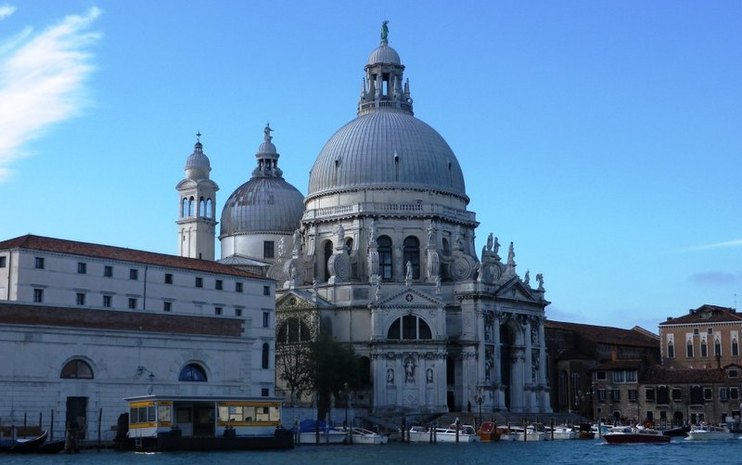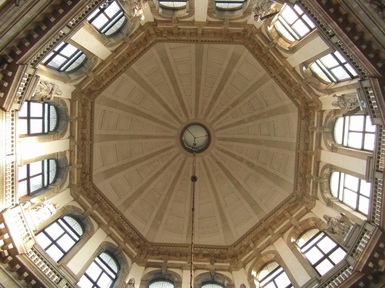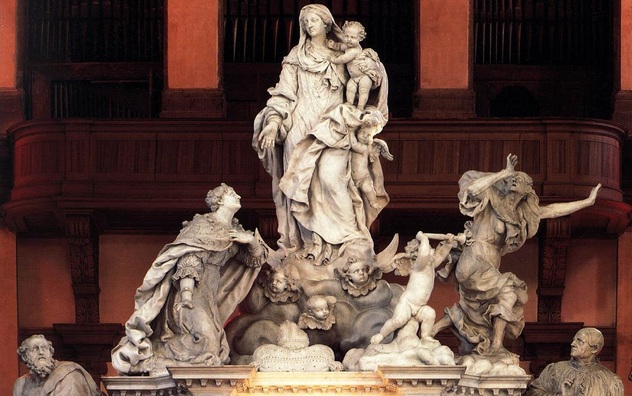Santa Maria della Salute
Open: 09-12.00/15.00-17.30.
The magnificent Baroque church of Santa Maria della Salute, one of the city’s most famous landmarks, was built as an act of gratitude for deliverance from an outbreak of the plague, which claimed, during the years 1630 and 1631, 46,000 lives, almost a third of the population.
A competition was duly held and the commission was won by Baldassare Longhena (1598-1682), a native of Venice. The successful architect declared that his design was to be ‘strange, worthy and beautiful…in the shape of a round machine, such as had never been seen or invented either in its whole or in part from any other church in the city', adding '...the dedication of this church to the Blessed Virgin made me think of designing the church, with what little talent God has bestowed on me, in forma rotonda, i.e. in the shape of a crown.' Santa Maria della Salute took more than fifty years to build and Longhena died shortly before it was consecrated.
Unlike the clean, spare, classical lines of Palladio's Il Redentore (an earlier 'plague' church), Santa Maria della Salute, known simply as La Salute, was built in the new Baroque style, heavily ornate, with massive volutes leading from the lower storey to the central dome.
The ground plan of the church is an octagon surmounted by a dome. The huge central area of the interior is surrounded by eight chapels, which are visible from the outside as two-storey porches. Dedicated to the Virgin, the church is full of Marian symbolism. The cupola represents her crown, the cavernous interior her womb, while the eight sides represent the eight points on her symbolic star. Standing on great scrolls, the twelve apostles represent the twelve stars in her crown. The symbolism continues inside the church where the centre of the elaborate pavement bears an inscription-unde origo inde salus (whence the origin, thence the salvation).
The Queen of Heaven Expelling the Plague, the sculptural group at the high altar, is a theatrical masterpiece by the Flemish artist, Giusto Le Corte. He and his assistants was responsible for most of the other statues inside and outside the church.
The Sacristy (entrance fee) should not be missed, as it is home to wonderful paintings by both Tintoretto and Titian. Here we find, inter alia, Tintoretto's Marriage at Cana and Titian's Saint Mark Enthroned with Saints.
A competition was duly held and the commission was won by Baldassare Longhena (1598-1682), a native of Venice. The successful architect declared that his design was to be ‘strange, worthy and beautiful…in the shape of a round machine, such as had never been seen or invented either in its whole or in part from any other church in the city', adding '...the dedication of this church to the Blessed Virgin made me think of designing the church, with what little talent God has bestowed on me, in forma rotonda, i.e. in the shape of a crown.' Santa Maria della Salute took more than fifty years to build and Longhena died shortly before it was consecrated.
Unlike the clean, spare, classical lines of Palladio's Il Redentore (an earlier 'plague' church), Santa Maria della Salute, known simply as La Salute, was built in the new Baroque style, heavily ornate, with massive volutes leading from the lower storey to the central dome.
The ground plan of the church is an octagon surmounted by a dome. The huge central area of the interior is surrounded by eight chapels, which are visible from the outside as two-storey porches. Dedicated to the Virgin, the church is full of Marian symbolism. The cupola represents her crown, the cavernous interior her womb, while the eight sides represent the eight points on her symbolic star. Standing on great scrolls, the twelve apostles represent the twelve stars in her crown. The symbolism continues inside the church where the centre of the elaborate pavement bears an inscription-unde origo inde salus (whence the origin, thence the salvation).
The Queen of Heaven Expelling the Plague, the sculptural group at the high altar, is a theatrical masterpiece by the Flemish artist, Giusto Le Corte. He and his assistants was responsible for most of the other statues inside and outside the church.
The Sacristy (entrance fee) should not be missed, as it is home to wonderful paintings by both Tintoretto and Titian. Here we find, inter alia, Tintoretto's Marriage at Cana and Titian's Saint Mark Enthroned with Saints.


